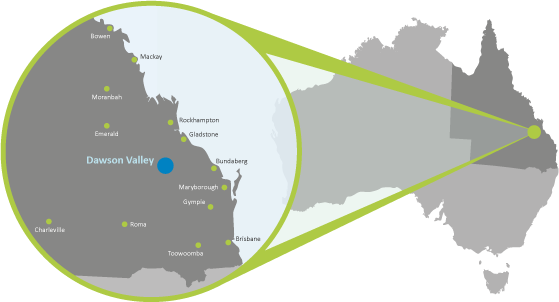Past review
15/05/2012
The Dawson Valley water supply scheme (WSS) and Theodore water distribution scheme are located near the town of Theodore, on the Dawson River.
The WSS has a total of 146 bulk customers (some of whom are also customers of the Theodore Distribution which draws its supply from Dawson Valley).
Storage for the Dawson Valley water supply scheme takes place in a number of weirs along the Dawson River. Among them:
- Theodore Weir – with a capacity of 4,760 ML
- Orange Creek Weir – with a capacity of 6,780 ML
- Moura Weir – with a capacity of 7,700 ML
- Glebe Weir – with a capacity of 17,700 ML
- Neville Hewitt Weir – with a capacity of 11,300
ML - Gyranda Weir – with a capacity of 16,500 ML
Water from this scheme is used to irrigate crops of cotton, fodder, cereal, wheat, barley, oats, maize, mung beans, soybeans, sunflowers, sorghum and peanuts.
It also provides water to the towns of Theodore, Moura, Baralaba and Duaringa.
The Theodore Distribution system consists of 46 km of open channels and 56 km of drains. Two channel sub-systems feature here:
- Theodore – supplied by the Theodore pumping
station with five pumps in total (three centrifugal, two on Castle Creek) - Gibber Gunyah – supplied by a pumping station
with three pumps.
The surface drains are a measure to remove run-off water from farming and stormwater.

The QCA’s recommended irrigation prices to apply to the Dawson Valley water supply scheme and Theodore distribution system for the 2012–17 regulatory period were published in May 2012. They are described in the Executive summary for each (see below) of our Final Report.
These recommendations were accepted by the Queensland Government, and the new price path came into effect on 1 July 2012.
This SunWater water scheme review forms part of the review that the QCA undertook in 2011–12 for the Queensland Government: the SunWater Irrigation Price Review 2012–17.
You can read more about the pricing review on our project home page. You can also view the submissions for the water schemes that we received, the consultants’ reports and issues arising from face-to-face consultation with stakeholders.
We recommended a new irrigation price path, to apply from July 2012 to June 2017 – with prices moving in a direction that better reflect costs. For the majority of schemes, our recommended prices result in increases to fixed prices and reductions in usage prices.
The irrigation revenue earned by SunWater in some schemes does not cover the cost of operating and maintaining irrigation assets. In these schemes, QCA could show the ‘cost-reflective’ price, but could only recommend prices that increased by up to $2/ML per year plus inflation.
The QCA’s recommended prices were accepted by the government.